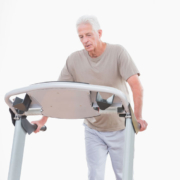Exercise for Peripheral Artery Disease
Peripheral arterial disease (PAD) is a narrowing of the arteries in the arms or legs, usually caused by the build-up of plaque similar to what can happen in the arteries of the heart or the neck. The result is pain in the muscles of the legs, sometimes mild, other times severe. As you might expect, the harder you exercise, the more potential for pain. Termed “intermittent claudication,” it can reduce mobility, or rather, the desire to be mobile.
Higher-intensity exercise such as fast walking is typically avoided due to the resulting pain. The prevailing recommendation is slow walking. But as several studies have determined, people won’t do it because it hurts. So why recommend it?
Researchers from several universities across the U.S. recruited over 300 subjects with a mean age of 69 to participate in a yearlong study on the effects of low-intensity versus high-intensity walking. This was a massive undertaking due to the extensive training and coaching for all subjects. I won’t keep you hanging until Saturday: the high-intensity walkers did better on physical tests than the low-intensity walkers or the control group. But there was one other critical point, and I’ll talk about that on Saturday.
What are you prepared to do today?
Dr. Chet
Reference: JAMA. 2021;325(13):1266-1276. doi:10.1001/jama.2021.2536.









